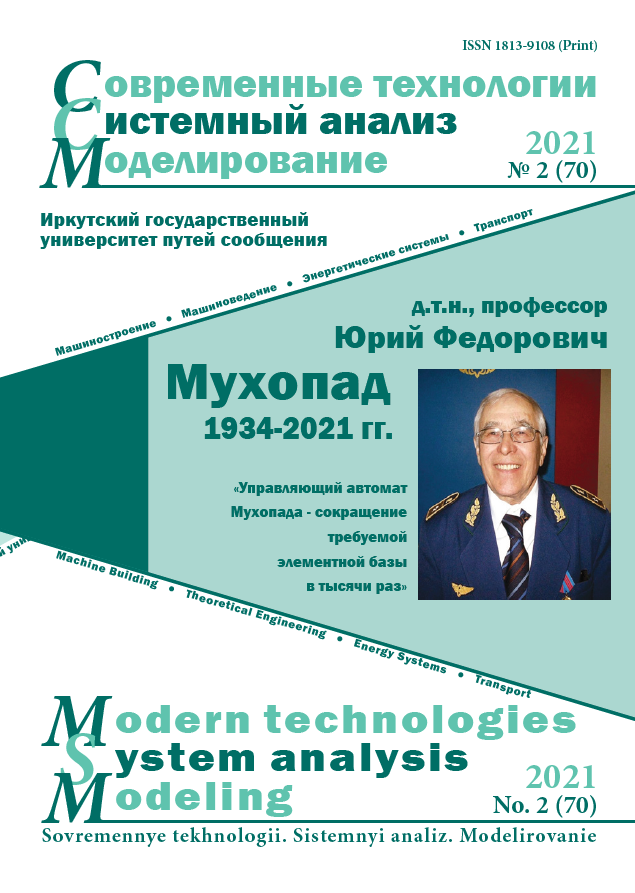The adaptive adding of sand for a locomotive wheelset
Keywords:
wheel spinning and skidding protection system, sand supply, current uncertainty, adaptive control system, identification algorithmAbstract
The article proposes a way to improve the protection system against wheel spinning and skidding (by the example of the fight against wheel spinning) of a modern locomotive, which is connected only with adding sand. Instead of the widely used method of automatic control of adding sand according to the relay principle, it is proposed to build a smooth regulation based on an adaptive control method. The latter is based on the algorithm of the current parametric identification of the mathematical model of the control object using an implicit reference model and “simplified” adaptability conditions. This control aims to eliminate the wheel spinning in necessary cases with the minimum possible consumption of sand, which increases the economic efficiency of transportation. It is assumed that the control is automatically generated and operated under conditions of uncertainty of the current characteristics of the wheel-rail adhesion, some train parameters, path inclination angle, etc. (or only approximate information about them), which is a typical situation in practice. Said control was built and investigated using a mathematical model of the wheel spinning process reduced to one locomotive wheelset that is described in the first part of the article. This simplifies consideration of the essence of the proposed method without reducing the commonality of conclusions on the more complex formulation of protective tasks on wheel spinning. Model examples of the functioning of the proposed sand supply control law for typical cases of wheel spinning are given: during the acceleration of the train when the traction exceeds the clutch force and when a train climbs uphill, running over oil spots on rails. The obtained theoretical conclusions and the results of model studies show the effectiveness of the proposed adaptive method of the sand adding control and the possibility of constructing a simple microprocessor system of sand adding control, which complements the standard locomotive system aimed at eliminating wheel spinning.
References
Kalker J.J. Survey of wheel-rail rolling contact theory // Vehicle system dynamics. 1979.Vol. 5. P. 317–358.
Теория электрической тяги : учебник для ВУЗов ж.-д. транспорта / С.И. Осипов, С.С. Осипов, В.П. Феоктистов. М. : Маршрут, 2006. 436 с.
Magel E., Kalousek J. The Application of Contact Mechanics to Wheel/Rail Profile Design. Proceedings of the 5th Inter-national Conference on Contact Mechanics and Wear of Rail/WheelSystems. Tokyo, 2000. P. 245–252.
Основные принципы управления системой противоюзовой защиты современного подвижного состава / Г.В. Го-гричиани, А.В. Казаринов, В.В. Михеев и др. // Вестник ВНИИЖТ. 2003. № 3. С. 14–21.
Самме Г.В. Фрикционное взаимодействие колесных пар локомотива с рельсами. Теория и практика сцепления локомотива : монография. М. : УМЦ по образованию на ж.-д. трансп., 2014. 104 с.
Бабков Ю.В., Базилевский Ф.Ю., Грищенко А.В. Автоматизация локомотивов : учеб. пособие для вузов ж.-д. транспорта. М. : УМЦ по образованию на ж.-д. трансп., 2007. 323 с.
Дядичко Г.П. Электровоз магистральный 2ЭС5К(3ЭС5К) : руководство по эксплуатации. Книга 1. Описание и работа. Новочеркасск, 2006. 267 с.
Иванов П.Ю., Хамнаева А.А., Худоногов А.М. Снижение энергопотребления электровоза при управлении пнев-матическими тормозами грузового поезда // Разработка и эксплуатация электротехнических комплексов и систем энер-гетики и наземного транспорта : материалы третьей междунар. науч.-практ. конф. 2018. С. 143–151.
Astrom K.J., Hagglund T. Advanced PID control // ISA. The Instrumentation Systems and Automation. Society. 2006. 461 p.
Ляпушкин Н.Н. Прогнозирование сцепных свойств локомотивов с различными типами тяговых электродвигателей : автореф. дис. … д-ра. техн. наук. М. : МИИТ, 2014. 46 с.
Теория электрической тяги / В.Е. Розенфельд, И.П. Исаев, Н.Н. Сидоров и др. М. : Транспорт, 1995. 294 с.
Первозванский А.А. Курс теории автоматического управления. СПб. : Лань, 2015. 624 с.
Савоськин А.Н., Чучин А.А. Исследование процессов срыва сцепления и буксования в тяговом приводе I класса // Моделирование транспортных процессов. 2009. № 2. С. 47–55.
Graupe D. Identification of Systems. Huntington. New York : Krieger, 1976. 276 p.
Круглов С.П. Условия адаптируемости систем управления с идентификатором и эталоном. Саарбрюккен : LAP LAMBERT, 2012. 125 c.
Круглов С.П. Сходимость невязки идентификации в системе управления с параметрической адаптацией // Ин-формационные технологии и математическое моделирование в управлении сложными системами : электр. науч. журн. 2019. № 1.40. С. 27-40. URL: http://ismm-irgups.ru/toma/12-2019 (дата обращения: 30.04.2021).
Раков В.А. Грузовые двенадцатиосные электровозы ВЛ85 // Локомотивы и моторвагонный подвижной состав железных дорог Советского Союза 1976–1985. М. : Транспорт, 1990.
Правила тяговых расчетов для поездной работы : утв. распоряжением ОАО «РЖД» от 12.05.2016 № 867р в ре-дакции распоряжения ОАО «РЖД» от 09.02.2018 № 182/р. 516 с.


